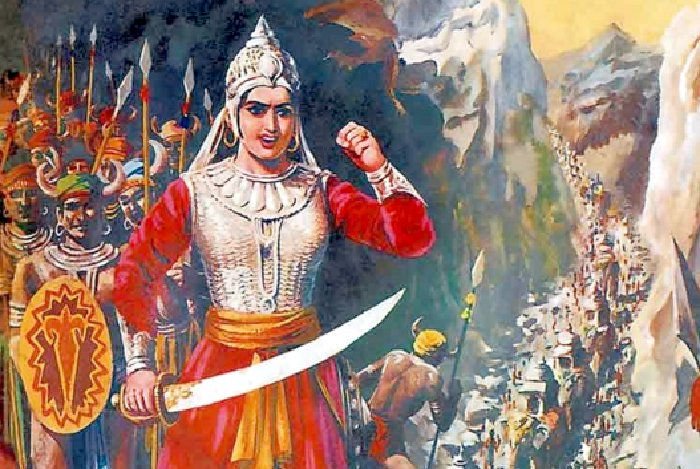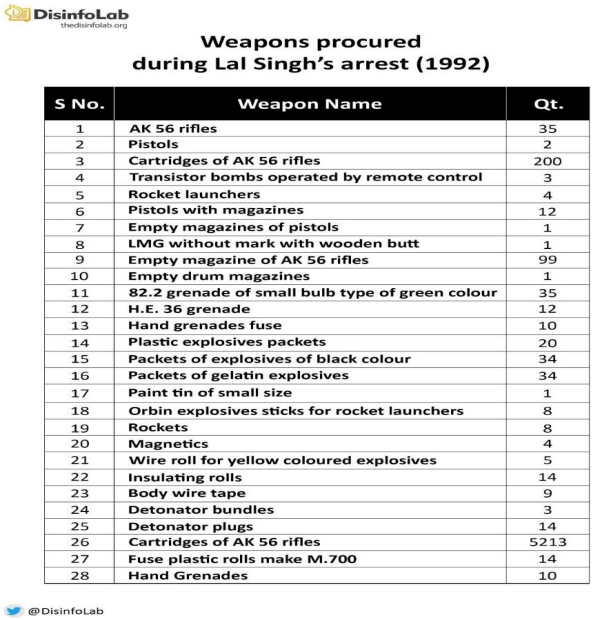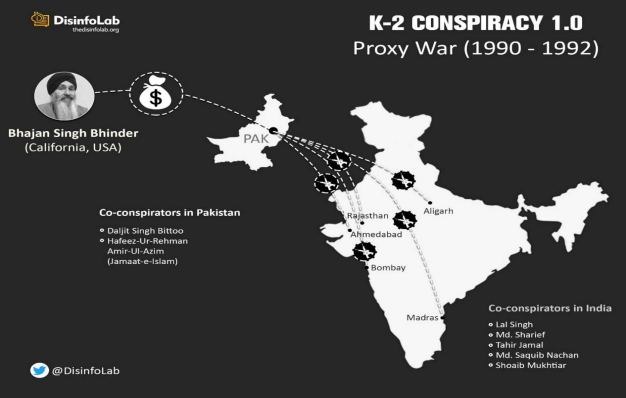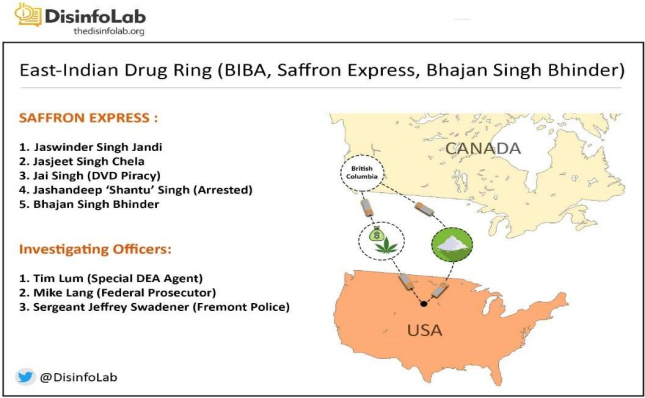The first Muslim invasion of India was by the Arabs who were led by Mahommad Bin Qasim. It took place in 711 A. D. and resulted in the conquest of Sindh. This first Muslim invasion did not result in a permanent occupation of the country because the Caliphate of Baghdad, by (1)
whose order and command the invasion had taken place, was obliged by the middle of the 9th century A. D. to withdraw its direct control from this distant province of Sindh. (2)
Soon after this withdrawal, there began a series of terrible invasions by Muhammad of Ghazni in 1001 AD Muhammad died in 1030 AD but within the short span of 30 years, he invaded India 17 times. He was followed by Mahommad Ghori who began his career as an invader in 1173. (3)
He was killed in 1206
Then followed the incursions of the Moghul hordes of Chenghiz Khan. They first came in 1221. They then only wintered on the border of India but did not enter it. Twenty years after, they marched on Lahore and sacked it. Of their inroads, the most terrible(4)
was under Taimur in 1398. Then comes on the scene a new invader in the person of Babar who invaded India in 1526.
(5)
The invasions of India did not stop with that of Babar. There occurred two more invasions. In 1738 Nadirshah's invading host swept over the Punjab like a flooded river "furious as the ocean." He was followed by Ahmadshah Abdalli who invaded India in 1761, smashed the forces of(6)
the Mahrattas at Panipat and crushed for ever the attempt of the Hindus to gain the ground which they had lost to their Muslim invaders.
(7)
In one of his dispatches to Hajjaj, Mahommad bin Qasim is quoted to have said :
"The nephew of Raja Dahir, his warriors and principal officers have been dispatched, and the infidels converted to Islam or destroyed. Instead of idol-temples, mosques and other places of worship (8)
have been created, the Kutbah is read, the call to prayers is raised, so that devotions are performed at stated hours. The Takbir and praise to the Almighty God are offered every morning and evening."
(Indian Islam by Dr. Titus, p. 10)
(9)
After receiving the above dispatch, which had been forwarded with the head of the Raja, Hajjaj sent the following reply to his general:
"Except that you give protection to all, great and small alike, make no difference between enemy and friend. God says, 'Give no quarter to (10)
infidels but cut their throats.' Then know that this is the command of the great God. You shall not be too ready to grant protection, because it will prolong your work. After this give no quarter to any enemy except those who are of rank."
(Quoted by Dr. Titus--Ibid., p. 10)(11)
Muhammad of Ghazni also looked upon his numerous invasions of India as the waging of a holy war. Al' Utbi, the historian of Muhammad, describing his raids writes:
"He demolished idol temples and established Islam. He captured cities, killed the polluted wretches, (12)
destroying the idolaters, and gratifying Muslims. He then returned home and promulgated accounts of the victories obtained for Islam. . . .and vowed that every year he would undertake a holy war against Hind."
(Ibid., p. 11)
(13)
Mahommed Ghori was actuated by the same holy zeal in his invasions of India. Hasan Nizami, the historian, describes his work in the following terms:
"He purged by his sword the land of Hind from the filth of infidelity and vice, and freed the whole of that country from the (14)
thorn of God-plurality and the impurity of idol-worship, and by his royal vigour and intrepidity left not one temple standing."
(Ibid., p. 11)
(15)
Taimur has in his Memoir explained what led him to invade India. He says:
"My object in the invasions of Hindustan is to lead a campaign against the infidels, to convert them to the true faith according to the command of Muhammad (on whom and his family be the blessing and (16)
peace of God), to purify the land from the defilement of misbelief and polytheism, and overthrow the temples and idols, whereby we shall be Ghazis and Mujahids, companions and soldiers of the faith before God".
(Quoted by Lane Poole in Medieval India, p. 155.)
(17)
Mahommad bin Qasim's first act of religious zeal was forcibly to circumcise the Brahmins of the captured city of Debul; but on discovering that they objected to this sort of conversion, he proceeded to put all above the age of 17 to death, and to order all others, with women (18)
children, to be led into slavery. The temple of the Hindus was looted, and the rich booty was divided equally among the soldiers, after one-fifth, the legal portion for the government, had been set aside. (19)
Muhammad of Ghazni from the first adopted those plans that would strike terror into the hearts of the Hindus. After the defeat of Raja Jaipal inA.D. 1001, Muhammad ordered that Jaipal "be paraded about in the streets so that his sons and chieftains might see him in that..(20)
condition of shame, bonds and disgrace; and that fear of Islam might fly abroad through the country of the infidels. (21)
"The slaughtering of 'infidels' seemed to be one thing that gave Muhammad particular pleasure. In one attack on Chand Rai, in A. D. 1019, many infidels were slain or taken prisoners, and the Muslims paid no regard to booty until they had satiated themselves with the slaughter(22)
of the infidels and worshippers of the sun and fire. The historian naively adds that the elephants of the Hindu armies came to Muhammad of their own accord, leaving idols, preferring the service of the religion of Islam."
(Dr. Titus, Indian Islam, p. 22.)
(23)
Not infrequently, the slaughter of the Hindus gave a great setback to the indigenous culture of the Hindus, as in the conquest of Bihar by Muhammad Bakhtyar Khilji. When he took Nuddea (Bihar) the Tabaquat-i-Nasiri informs us that:
(24)
(To be continued)
"great plunder fell into the hands of the victors. Most of the inhabitants were Brahmins with shaven heads. They were put to death. Large number of books were found. . . .but none could explain their contents as all the men had been killed, the whole fort and city being a (25)
place of study."
(Dr. Titus, Indian Islam, p. 22.)
Summing up the evidence on the point, Dr. Titus concludes :
(26)
"Of the destruction of temples and the desecration of idols we have an abundance of evidence. Mahommad bin Qasim carried out his plan of destruction systematically in Sind, we have seen, but he made an exception of the famous temple at Multan for purposes of revenue,(27)
as this temple was a place of resort for pilgrims, who made large gifts to the idol. Nevertheless, while he thus satisfied his avarice by letting the temple stand, he gave vent to his malignity by having a piece of cow's flesh tied around the neck of the idol." (28)
"Minhaj-as-Siraj further tells how Mahommad became widely known for having destroyed as many as a THOUSAND TEMPLES, and of his great feat in destroying the temple of Somnath and carrying off its idol, which he asserts was broken into four parts. (29)
One part he deposited in the Jami Masjid of Ghazni, one he placed at the entrance of the royal palace, the third he sent to Mecca, and the fourth to Medina."
(Ibid., pp. 22-23) (30)
It is said by Lane Poole that Muhammad of Ghazni "who had vowed that every year should see him wage a holy war against the infidels of Hindustan" could not rest from his idol-breaking campaign so long as the temple of Somnath remained inviolate. It was for this specific (31)
purpose that he, at the very close of his career, undertook his arduous march across the desert from Multan to Anhalwara on the coast, fighting as he went, until he saw at last the famous temple:
(32)
"There a hundred thousand pilgrims were wont to assemble, a thousand Brahmins served the temple and guarded its treasures, and hundreds of dancers and singers played before its gates. Within stood the famous linga, a rude pillar stone adorned with gems and lighted by... (33)
jewelled candelebra which were reflected in rich hangings, embroidered with precious stones like stars, that decked the shrine. . . .Its ramparts were swarmed with incredulous Brahmins, mocking the vain arrogance of foreign infidels whom the God of Somnath would assuredly... (34)
The foreigners, nothing daunted, scaled the walls; the God remained dumb to the urgent appeals of his servants; fifty thousand Hindus suffered for their faith and the sacred shrine was sacked to the joy of the true believers. The great stone was cast down and its fragments (35)
were carried off to grace the conqueror's palace. The temple gates were setup at Ghazni and a million pounds worth of treasure rewarded the iconoclast."
(Lane Poole, Medieval India, p. 26.)
(36)
The work done by Muhammad of Ghazni became a pious tradition and was faithfully followed by those who came after him. In the words of Dr. Titus:
(37)
"Mahommad Ghori, one of the enthusiastic successors of Muhammad of Ghazni, in his conquest of Ajmir destroyed pillars and foundations of the idol-temples, and built in their stead mosques and colleges, and the precepts of Islam and the customs of the law were divulged and...(38)
established. At Delhi, the city and its vicinity were freed from idols and idol worship, and in the sanctuaries of the images of the Gods mosques were raised by the worshippers of the one God."
(39)
"Qutb-ud-Din Aybak also is said to have destroyed nearly a thousand temples, and then raised mosques on their foundations. The same author states that he built the Jami Masjid, Delhi, and adorned it with the stones and gold obtained from the temples which had been demolished(40)
by elephants, and covered it with inscriptions (from the Quran) containing the divine commands. We have further evidence of this harrowing process having been systematically employed from the inscription extant over the eastern gateway of this same mosque at Delhi, which (41)
relates that the materials of 27 idol temples were used in its construction."
"Ala-ud-Din, in his zeal to build a second Minar to the Jami Masjid, to rival the one built by Qulb-ud-Din, is said by Amir Khusru not only to have dug stones out of the hills, but to have... (42)
demolished temples of the infidels to furnish a supply. In his conquests of South India the destruction of temples was carried out by Ala-ud-Din as it had been in the north by his predecessors." (43)
"The Sultan Firoz Shah, in his Futuhat, graphically relates how he treated Hindus who had dared to build new temples. 'When they did this in the city (Delhi) and the environs, in opposition to the law of the Prophet, which declares that such are not to be tolerated, under (44)
Divine guidance I destroyed these edifices. I killed these leaders of infidelity and punished others with stripes, until this abuse was entirely abolished and where infidels and idolaters worshipped idols, Musalmans now by God's mercy perform their devotions to the true God"(45)
Even in the reign of Shah Jahan, we read of the destruction of the temples that the Hindus had started to rebuild, and the account of this direct attack on the piety of the Hindus is thus solemnly recorded in the Badshah-namah: (46)
"It had been brought to the notice of His Majesty, says the historian, that during the late reign (of Akbar) many idol-temples had been begun but remained unfinished at Benares, the great stronghold of infidelity. The infidels were now desirous of completing them. (47)
His Majesty, the defender of the faith, gave orders that at Benares and throughout all his dominions in every place all temples that had been begun should be cast down. It was reported from Allahabad that 76 temples had been destroyed in the district of Benares."
(48)
It was left to Aurangzeb to make a final attempt to overthrow idolatry. The author of 'Ma'athir-i-Alamgiri dilates upon his efforts to put down Hindu teaching, and his destruction of temples in the following terms :
(49)
(To be continued)
"In April, A. D. 1669, Aurangzib learned that in the provinces of Thatta, Multan and Benares, but especially in the latter, foolish Brahmins were in the habit of expounding frivolous books in their schools, and that learners, Muslims as well as Hindus, went there from long (50)
distances. . . .The 'Director of the Faith' consequently issued orders to all the governors of provinces to destroy with a willing hand the schools and temples of the infidels; and they were enjoined to put an entire stop to the teaching and practising of idolatrous worship.(51)
Later it was reported to his religious Majesty that the Government officers had destroyed the temple of Bishnath at Benares."
(52)
Muhammad not only destroyed temples but made it a policy to make slaves of the Hindus he conquered. In the words of Dr. Titus:
(53)
"Not only was slaughter of the infidels and the destruction of their temples resorted to in earlier period of Islam's contact with India, but as we have seen, many of the vanquished were led into slavery. The dividing up of booty was one of the special attractions, to the (54)
as well as to the common soldiers in these expeditions. Muhammad seems to have made the slaughter of infidels, the destruction of their temples, the capturing of slaves, and the plundering of the wealth of the people, particularly of the temples and the priests, the main (55)
object of his raids. On the occasion of his first raid he is said to have taken much booty ; and half a million Hindus, 'beautiful men and women,' were reduced to slavery and taken back to Ghazni." (56)
When Muhammad later took Kanauj, in A. D. 1017, he took so much booty and so many prisoners that 'the fingers of those who counted them would have tired.' Describing how common Indian slaves had become in Ghazni and Central Asia after the campaign of A. D. 1019, the... (57)
historian of the time says :
"The number of prisoners may be conceived from the fact that each was sold for from two to ten dirhams. These were afterwards taken to Ghazni, and merchants came from far distant cities to purchase them; and the fair and the dark, the rich and..(58)
the poor were commingled in one common slavery."
"In the year A.D. 1202, when Qulb-ud-Din captured Kalinjar, after the temples had been converted into mosques, and the very name of idolatry was annihilated, fifty thousand men came under the collar of slavery and the plain... (59)
became black as pitch with Hindus."
Slavery was the fate of those Hindus who were captured in the holy war. But, when there was no war the systematic abasement of the Hindus played no unimportant part in the methods adopted by the Muslim invaders. In the days of Ala-ud-Din, (60)
at the beginning of the fourteenth century, the Hindus had in certain parts given the Sultan much trouble. So, he determined to impose such taxes on them that they would be prevented from rising in rebellion.
(61)
"The Hindu was to be left unable to keep a horse to ride on, to carry arms, to wear fine clothes, or to enjoy any of the luxuries of life."
(Dr. Titus, Indian Islam, p. 29.)
(62)
Speaking of the levy of Jizyah Dr. Titus says:
"The payment of the Jizyah by the Hindus continued throughout the dominions of the sultans, emperors, and kings in various parts of India with more or less regularity, though often, the law was in force in theory only; since it (63)
depended entirely on the ability of the sovereign to enforce his demands. But, finally, it was abolished throughout the Moghul Empire in the ninth year of the enlightened Akbar's reign (A. D. 1665), after it had been accepted as a fundamental part of Muslim government (64)
policy in India for a period of more than eight centuries."
(65)
Lane Poole says that
"the Hindu was taxed to the extent of half the produce of his land, and had to pay duties on all his buffaloes, goats, and other milk-cattle. The taxes were to be levied equally on rich and poor, at so much per acre, so much per animal. Any collectors (66)
or officers taking bribes were summarily dismissed and heavily punished with sticks, pincers, the rack, imprisonment and chains. The new rules were strictly carried out, so that one revenue officer would string together 20 Hindu notables and enforce payment by blows. (67)
No gold or silver, not even the betelnut, so cheering and stimulative to pleasure, was to be seen in a Hindu house, and the wives of the impoverished native officials were reduced to taking service in Muslim families. Revenue officers came to be regarded as more deadly (68)
than the plague; and to be a government clerk was disgrace worse than death, in so much that no Hindu would marry his daughter to such a man."
(69)
If you made it till here, thanks for reading the whole thread, it means a lot! :)
Source - Pakistan or the partition of India by B.R. Ambedkar





























